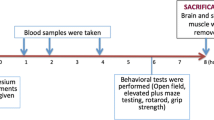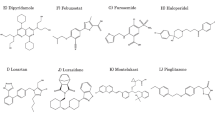Abstract
Wuji Wan (WJW), containing Rhizoma Coptidis (Huanglian in Chinese, HL), Frutus Evodiae Rutaecarpae (Wuzhuyu, WZY) and Radix Paeoniae Alba (Baishao, BS), is a classical traditional Chinese medical formula employed in treating intestinal disorders. Berberine (BBR) and palmatine (PMT) are the major active alkaloids in HL and have analgesic and anti-microbial effects. A sensitive, specific and validated ultra-performance liquid chromatography–tandem mass spectrometric method was developed to investigate the pharmacokinetic profiles of BBR and PMT in rat plasma and in situ intestinal perfusion solution. In comparison with the pharmacokinetic parameters of BBR and PMT, t 1/2, C max, T max, AUC, CL and MRT after intragastric (i.g.) administration with HL extract alone, those remarkably changed after i.g. administration with WJW formulas 1 and 2 (herb proportions are 12:2:3 and 12:1:12). Particularly, the oral bioavailability of PMT in WJW formula 1 was significantly increased. In rat intestinal perfusion experiments, the apparent permeability coefficient value of PMT was (1.45 ± 0.72) × 10−5 cm/s when perfusion with HL was performed, and the value was significantly increased to (3.92 ± 0.52) × 10−5 cm/s on perfusion with WJW formula 1. These results indicate that the pharmacokinetic parameters and absorption of BBR and PMT are affected by the other herbs or ingredients from WJW formulas.




Similar content being viewed by others
References
Bao TD, Li YJ, Yang Q et al (2010) LC/MS determination of berberine and palmatin in rats plasma after oral administration of extracts Rhizoma Coptidis and its pharmacokinetics study. Chin J Exp Tradit Med Formulae 16:186–189
Bent S, Ko R (2004) Commonly used herbal medicines in the United States: a review. Am J Med 116:478–485
Chen W, Miao YQ, Fan DJ et al (2011) Bioavailability study of berberine and the enhancing effects of TPGS on intestinal absorption in rats. AAPS Pharm Sci Tech 12:705–711
Di B, Feng NP, Liu WY (2006) Pharmacokinetic comparisons of Shuang–Huang–Lian with the different combinations of its constitutional herbs. J Ethnopharmacol 107:401–405
Lu T, Song J, Huang F, Deng YX et al (2007) Comparative pharmacokinetics of baicalin after oral administration of pure baicalin, Radix scutellariae extract and Huang–Lian–Jie–Du–Tang to rats. J Ethnopharmacol 110:412–418
Tjong YW, Lp S, Lao LX et al (2011) Analgesic effect of Coptis chinensis rhizomes (Coptidis Rhizoma) extract on rat model of irritable bowel syndrome. J Ethnopharmacol 135:754–761
Wang YJ (2006) Experimental studies of therapeutic effects of Wuji Wan in different compatibilities on irritable bowel syndrome, unpublished M.S dissertation, Institute of Chineses Materia Medica, China Academy of Chinese Medical Sciences, 32–52
Wang WP, Wang CJ (2009) Pharmacokinetic studies of the significance of herbaceous compatibility of peony liquorice decoction. World Sci Technol Mod Tradit Chin Med Mater 11:382–387
Weng XG, Li YJ, Yang Q et al (2010) Effects of Wuji Pill with different compatibility on the activity of cytochrome P450 1A2 in rat liver microsomes in Vitro. World Chin J Digestol 18:586–591
Xu SJ, CX CX, Gao JP (2006) Attenuated effect of active components of radix glycyrrhizae on radix Aconiti laterlis and the related mechanisms. Chin Tradit Patent Med 28:526–530
Zhang X, Qiu F, Jiang J et al (2011) Intestinal absorption mechanisms of berberine, palmatine, jateorhizine, and coptisine: involvement of P-glycoprotein. Xenobiotica 41:290–296
Zhou HZ, Yu HM, Peng QX et al (2008) Progress in chemical composition, pharmacology and the natures for different ratios of Coptis chinensis and fructus evodiae. Chin J Exp Tradit Med Formulae 14:75–77
Zou LJ, Chen Y, Yang Q et al (2012) Effect on compatibility on intestinal absorption of alkaloids in Rhizoma Coptidis in rats. Chin J Exp Tradit Med Formulae 18:260–264
Acknowledgments
This research was supported by the National Natural Science Foundation of China (30930114 and 81001684), National Science Foundation for Post-doctoral Scientists of China (20110490554) and Autonomous Program of China Academy of Chinese Medical Sciences (ZZ20090101).
Author information
Authors and Affiliations
Corresponding author
Rights and permissions
About this article
Cite this article
Chen, Y., Li, Y., Wang, Y. et al. Comparative pharmacokinetics of active alkaloids after oral administration of Rhizoma Coptidis extract and Wuji Wan formulas in rat using a UPLC–MS/MS method. Eur J Drug Metab Pharmacokinet 40, 67–74 (2015). https://doi.org/10.1007/s13318-014-0181-1
Received:
Accepted:
Published:
Issue Date:
DOI: https://doi.org/10.1007/s13318-014-0181-1




